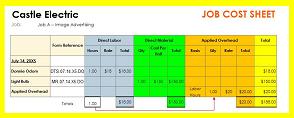

 |
Back to the Data Model
The Draft Business Rules have been defined and are listed below.
The Area being Modelled is Job Costing and Profitability:-
A. This is a Statement of the Requirements.
The requirement
To track the material and labour costs of a Job so profit can be calculated from this.
To track who did what in the course of getting that Job done.
Conceptually
A Job is requested by a Client.
Each Job is completed after a series of Subjobs are done.
Each Subjob is done by a Worker.
Each Subjob has an associated Material cost.
Each Worker has an associated Labour rate cost.
Practically
Each Job is registered to a Client for a Job Type and given a Job number. The Payment amount
for the Job is also recorded.
The Worker registers the Subjob for that particular Job putting in details of who did it, what
type of subjob was done, when it was started and when it was finished.
Problems with reporting history
There are two derived data values in what is required of this system:
Subjob labour cost: subjob hours times worker's labour rate cost
Profit: Job payment minus total Job cost (material plus labour cost).
Since material and labour costs will change with time, I believe there would be problems with
historically comparing Subjob labour cost and Profit from one year to another with the current schema
since there is only a single field to record the values from which the data in question is derived?
That being the case, is this where the the "date from" field comes in as shown in your Tutorial ?
Thanks!
Kevin
B. The Things of Interest, ('THINGS'), include :-
B.1 Clients
B.2 Jobs
B.3 Sub Jobs
B.4 Workers
B.5 Others to be determined.
C. These THINGS are Related as follows :-
C.1 To be determined.
D. Other Characteristics of these THINGS include :-
D.1 To be determined.
E. Sample Data includes :-
E.1 To be determined.
F. Typical Enquiries include :-
F.1
|
| |
Barry Williams
January 29th. 2010
Principal Consultant
Database Answers
|
|



